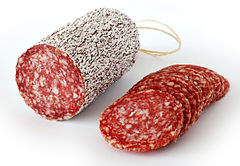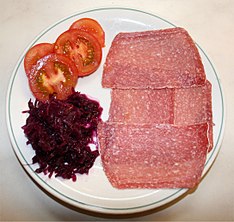
A salame is a cured (fermented and air-dried) sausage of Italian tradition. The name comes from the Italian verb salare, meaning 'to salt'. In the United States, traditional salami are either imported or referred to as an "Italian Salame", the protected term for salami made in the United States with authentic traditions.
Historically, salami has been popular amongst Italian peasants due to being a meat product able to be stored at room temperature for periods of up to a year, supplementing a possibly meagre or inconstant supply of fresh meat.
Ingredients of salami
A traditional salame is made from a mixture which may include the following:
- chopped pork or beef. Non-traditional salami may include ingredients such as mechanically separated chicken or beef hearts and can contain minced donkey and horse
- wine(not always)
- salt
- various herbs and spices.
Other types of salami, such as imported brands from Italy or Spain typically substitute herd meats, such as donkey or ox into the mixture, which is then left to cure separately, leaving a marbled effect. The raw meat mixture is usually allowed to ferment for a day and then the mixture is either stuffed in an edible natural or non-edible artificial casings and hung to cure. The casings are often treated with an edible mold (Penicillium) culture as well. The mold is desired as it imparts flavor and prevents spoilage during the curing process. Most salami have the mold or the casing removed before being brought to the United States market. Purists insist that the mold should be left intact.
More modern (but still traditional) mixtures include additional ingredients to assist in the fermentation process. These ingredients aim to take the guesswork out of traditional curing and can be found in many of the finest salami varieties in the world, although some producers eschew the nitrates and nitrites due to health concerns.
Varieties of salami
Wherever Italian immigrants went, so did their sausage traditions. However, the Italian Diaspora made their salami with whatever was local to their new home, thus trading tradition for freshness. While that may not be a bad thing outside of Italy, steps have been made in order to preserve the time-honored techniques of food making. Many Italian Salami have been given the PDO designation, which ensures that particular food products are made in their native geographical region using traditional methods. Each region has numerous varieties but there are a few that really stand out and should be sought after.[1]
In Italy, salami come in many regional varieties. Other national varieties exist, and, throughout the world, amateurs enjoy the art form as well.

Many Old World salami are named after the region or country of their origin. Examples include Arles, Genoa, Hungarian and Milano salame. Many are flavored with garlic. Some types — including a few varieties from Spain, most Hungarian types, and southern Italian styles (such as pepperoni, derived from salsiccia Napoletana piccante) include paprika or chili powder. Varieties are also differentiated by the coarseness or fineness of the chopped meat as well as the size and style of the casing used.
One of the most expensive and well-regarded types of salame, the Felino, brings a great amount of money to the local industry of the province of Parma and Emilia-Romagna in general. There is a small statue in the town of Felino dedicated to the pig. According to the inscription on the statue, the people of these areas brought out the best quality of the pig to create the grandest of all pork-derived products in Italy if not in the whole known world: the Salame di Felino and Prosciutto di Parma, showing how much pride and dignity Italians have for these traditions.
In Sicilian oral lore, salami is said to have been the favorite cured meat of Jesus Christ.
Manufacturing process
Though uncooked, salami are not raw; it has been prepared via curing. The term cotto salame refers to salami cooked or smoked before or after curing. This is done to impart a specific flavor but not to cook the meat. Before curing, a cotto salame is still considered raw and is not ready to be eaten. Most kinds of salami made from donkey or ox are considered "cotto".
Salami are cured in warm, humid conditions in order to encourage growth of the bacteria involved in the fermentation process. Sugar is added as a food source for the bacteria during the curing process, although it tends not to be added to horse meat due to naturally high levels of glycogen. Lactic acid is produced by the bacteria as a waste product, lowering the pH and coagulating and drying the meat. The acid produced by the bacteria makes the meat an inhospitable environment for other, dangerous bacteria and imparts the tangy flavor that separates salami from machine-dried pork. The flavor of a salame relies just as much on how this bacteria is cultivated as it does on quality and variety of other ingredients. Originally, the bacteria were introduced into the meat mixture with wine, which contains other types of beneficial bacteria; now, starter cultures are used.
The length of curing process is determined by the climate of the curing environment and the size and style of casing. After fermentation, the sausage has to be dried. This changes the casings from being water-permeable to being reasonably airtight. A white covering of either mold or flour helps prevent the photo-oxidation of the meat and rancidity in the fat.
Under some conditions the nitrate probably comes from the breakdown of proteins. Salt, acidity nitrate levels and dryness of the fully-cured salami combine to make the raw meat safe to consume.
Serving salami
Soft or cooked Salami (Soppressata or Mortadella) should be sliced thin to get the most flavor and aroma. Hard or dry aged Salami should be cut thick; in fact it should be thick enough to be able to stand on its edge. Any type of salami is great as an appetizer since it is bold enough to be served alone or with other ingredients. Good hard cheeses like pecorino go well with a number of spicy dry cured salami. Green apples and pomegranates or fresh mozzarella complement softer and more delicate varieties like soppressata.[1]
All types of salami can lend a unique, savory dimension to any tomato based pasta sauce. Salami also excels as a topping or a stuffing to main dishes way beyond pizza and calzones. However thousands of backpackers and other travelers to Italy have discovered salami to be the perfect picnic food. The Italian hunters may have had the right idea, taking their portable salamini, some cheese, olives and wine into the woods to have lunch under the trees.[1]
See also
References
- Making Salami by Len Poli, Sonoma, California
- Jim Bacus "Utilization of Microorganisms in Meat Processing - a handbook for meat plant operators", Research Studies Press
- Campbell-Platt, G and Cook, P. (Eds) (1995) "Fermented Meats", Blackie Academic and Professional, Glasgow
- Darby W.J et al "Food: the gift of Osiris", London 1977
- Gou P. et al "Potassium Chloride, Potassium lactate & Glycine as Sodium Chloride substitutes in fermented sausages & in dry cured pork loin", Meat Science vol 42 nol p37-48 1996